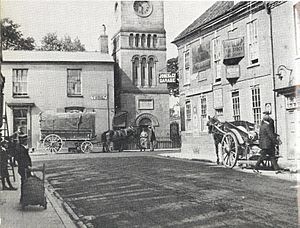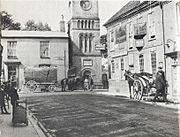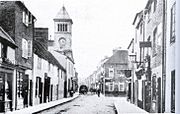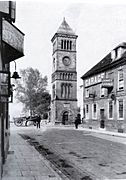Lichfield Clock Tower facts for kids
Quick facts for kids Lichfield Clock Tower |
|
|---|---|
|
Friary Clock Tower
|
|
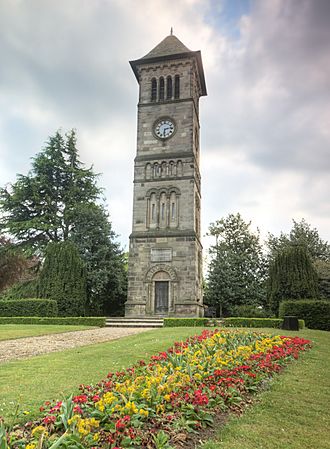 |
|
| Former names | Crucifix Conduit Tower |
| General information | |
| Type | Clock tower |
| Architectural style | Norman |
| Town or city | Lichfield |
| Country | |
| Completed | 1863 |
| Cost | £1,200 |
| Client | Lichfield Conduit Lands Trust |
| Owner | Lichfield City Council |
| Design and construction | |
| Architect | Joseph Potter Jnr |
The Lichfield Clock Tower, also known as the Friary Clock Tower, is a cool old clock tower from the 1800s. It's a special building, listed as Grade II, found in Lichfield, Staffordshire, United Kingdom. You can spot it near Festival Gardens.
This tower was first built in 1863. It stood where Bird Street and Bore Street met. It was placed over an old water system called the Crucifix Conduit. This conduit had supplied water to the Friary since 1301. As cars became popular in the early 1900s, these streets got very busy. The clock tower's spot made traffic even worse. So, in 1928, a new road called 'The Friary' was built. The tower had to be moved about 400 meters (about a quarter-mile) west to its current spot.
The Tower's Story
In the mid-1800s, building clock towers was very popular in England. After the famous Big Ben was built in London in 1858, the city council in Lichfield thought it would be a great idea to have their own clock tower too.
They thought about a few places for the tower. Some suggested putting it on top of the Guildhall. Others thought it could go in the Market Square, perhaps even with the statue of Samuel Johnson. But these ideas didn't work out. Instead, they decided to build the tower at the crossing of Bore Street and Bird Street. It would sit over the old Crucifix Conduit, which was no longer used.
The tower was designed by an architect named Joseph Potter Jnr. He designed it in a style called Norman, which is a bit like old castles. The Lichfield Conduit Lands Trust paid for the tower, and it cost them £1200.
When it was first finished, the tower only had three clock faces. They didn't think a fourth face was needed on the west side because it only looked at one building, the Friary. But the person living at the Friary complained, so a fourth face was added. For a while, the clock wasn't very accurate. But in 1898, a company called Joyce of Whitchurch fixed the whole clock system, and it worked much better.
Moving the Clock Tower
In 1920, a large piece of land, about 11 acres, called the Friary estate was sold. Sir Richard Ashmole Cooper, who was a Member of Parliament for Walsall, bought it. He then gave the land to the city. His idea was for the city to develop the area and build a new road.
For many years, as more and more cars appeared, Bird Street and Bore Street became very crowded. They were narrow streets, and the clock tower sitting in the middle made the traffic problems worse. By 1920, the west side of Lichfield wasn't very developed. The city didn't really stretch much beyond St John's Street to the west.
So, in 1928, the new road called 'The Friary' was built right across the old Friary site. Because of this new road, the clock tower had to be moved. The tower was carefully taken down and then put back up in its current spot. This new location is south of Festival Gardens, about 400 meters (or a quarter-mile) west of where it used to be. In 1991, the tower was repaired and restored with help from the Conduit Lands Trust. Today, the Lichfield City Council takes care of this historic clock tower.
Gallery


